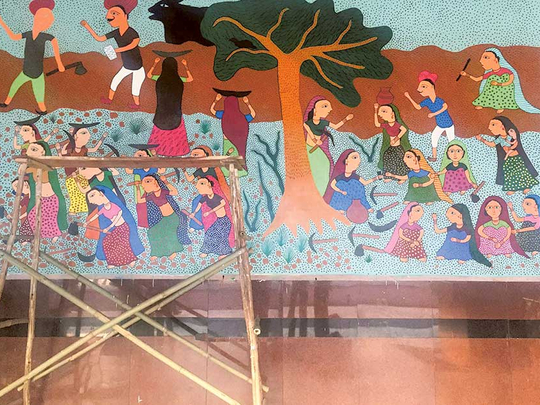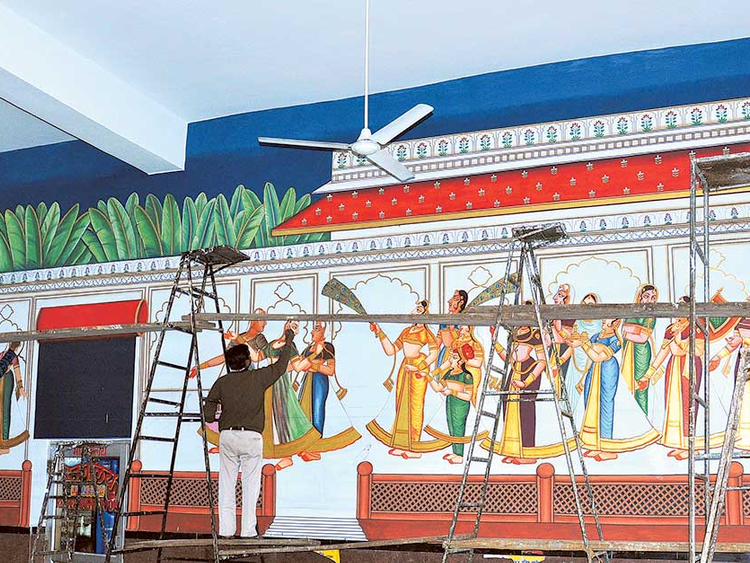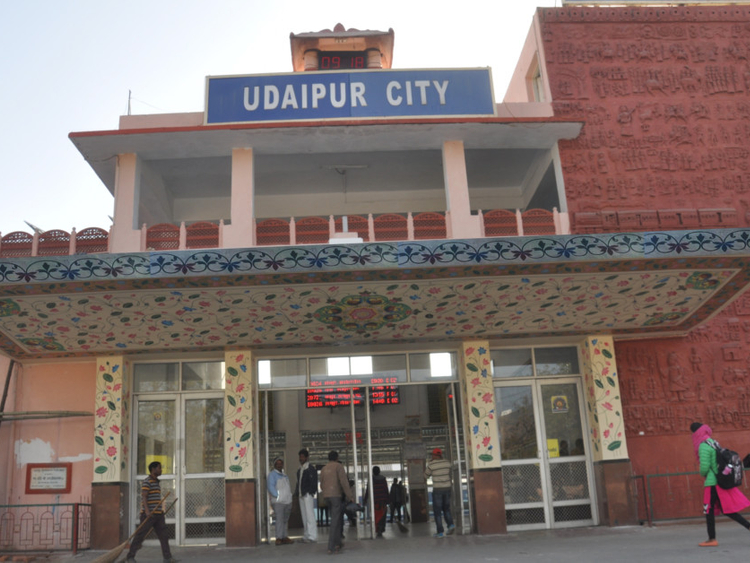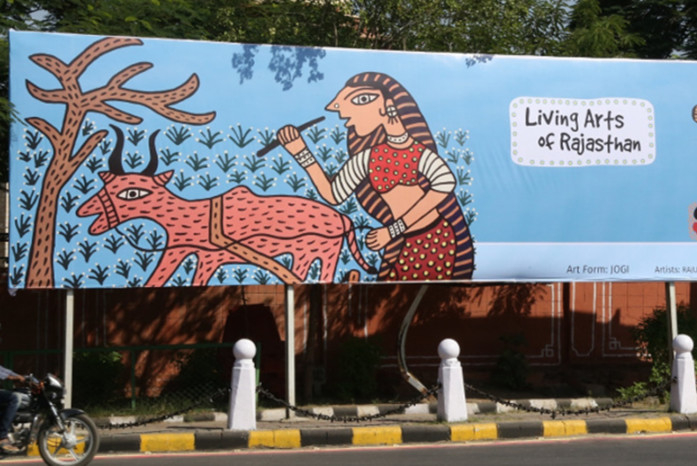
Not too long ago, public walls in India wouldn’t warrant a second glance — they were drab, dirty, in disrepair and ubiquitously stained with betel juice people spat on them. That was until street art came to the rescue, at least in metropolitan cities. And now, the western state of Rajasthan, renowned for its bright hues that stand out against its desert sands and the intricate, frescoed havelis of the Shekhawati region, is taking an artistic leap ahead. It is promoting the state’s dying folk arts by depicting them on the walls of its railway stations.
It all started one fine day last October, when the state’s capital Jaipur woke up to vibrant hoardings displaying Jogi paintings at 40 places around the city. The tribal art form, composed of complex images made up of dots and lines, is practised in Magriwada village of Sirohi district, 487 kilometres from Jaipur.
The Jaipur Municipal Corporation (JMC) had invited five Jogi artists to create independent colour as well as black-and-white Jogi art pieces. These were displayed at bus shelters, on bus panels and hop-on-hop-off buses. Each hoarding carried the name and photograph of the artist who created it.
The following month, hand-painted auto-rickshaws, showcasing Rajasthan’s culture and heritage, began plying the city streets as the investors’ summit Resurgent Rajasthan started in Jaipur. Fine arts students from various universities had worked on 100 auto-rickshaws for this project to promote folk art. This colourful surprise not just amused the guests and participants, but also raised awareness among local residents about preserving their heritage.
The initiative to have murals at the railway stations is the latest in the line. The 5,000 feet of walls of tiny railway station of Sawai Madhopur, the gateway to the famous Ranthambore Tiger Reserve in eastern Rajasthan, have been lavishly painted with the flora and fauna that the reserve hosts — darters, tree-pies, hyenas, bears, leopards, and of course tigers. The railway station is now a grand reflection of Ranthambore’s diverse wildlife and has become a “heritage railway station”.
On February 25, Indian Railway Minister Suresh Prabhu, while presenting the railway budget for 2016-17, lauded this “unique attempt to combine cleanliness with creativity”. “I had appealed to numerous social organisations to come forward to beautify our stations. I am happy to inform the House that walls of many stations have been converted to murals, which have not only improved the aesthetics but also spread awareness on socially relevant themes. One such theme that deserves special mention is wildlife conservation illustrated through the paintings at the Sawai Madhopur Station. Hazaribagh, Borivali, Khar, Udaipur, Bikaner are some of the other stations which showcase local art and talent. I thank them all and request similar support next year for aesthetic upgrade of our stations. We will make special efforts to showcase tribal art,” he said.
The mural at Sawai Madhopur station is the work of a team of artists from Ranthambore School of Art, led by two master painters, Gajanand Singh and Narayan Singh.
The Ranthambore School of Art, founded in 1988 by India’s “tigerman” Valmik Thapar through the NGO Ranthambore Foundation, has trained more than 250 local people as wildlife artists.
Thapar presented the concept for the mural to Prabhu, who served as the environment and forest minister in the earlier NDA government. Prabhu, it is learnt, immediately took to the idea. The exercise called for a small sponsorship and World Wildlife Fund (WWF) India, stepped in to provide the requisite funding.
“It is not just tourists and foreigners who are excited to see the paintings, but also the locals. They say they’ve never seen anything like this. They click pictures with the paintings,” Gajanand Singh told www.thenewsminute.com, a digital news platform reporting and writing on issues in India. “Some say they don’t even need to go to the national park now that they have seen the art at the station,” he added.
“The station has become a living art museum of wildlife. The junglescape has created a buzz. People are curious, excited, and are asking questions, taking photographs. It is generating awareness and will have other ripple effects,” the website DailyO.in quoted Thapar as saying. Thapar hopes that this unique effort will be replicated at other stations and public, with murals that reflect the natural and culture heritage of the region.
Taking a cue from the Prime Minister’s Swachh Bharat Abhiyan (the Clean India campaign), Rajasthan Chief Minister Vasundhara Raje wrote to the union railway minister on April 16 last year, requesting that the railway stations in the state be given a thematic facelift. Sawai Madhopur, the first station to get painted, was ready in December.
The Jaipur railway station was next, and was done up in Jogi art. The two smaller stations in the capital — Gandhi Nagar and Durgapura — are in the process of having murals depicting traditional Rajasthani puppets and the Jaipur skyline. One of Jaipur’s new Metro stations, Mansarovar, got a 200-foot graffiti wall, replete with the city’s landmarks and cultural icons, such as puppets and elephants, and festivals such as Navratra and Gangaur.
The Jodhpur railway station is being beautified with Phad paintings. These huge paintings are done on cloth and depict stories of local deities. The scale of the figures in the paintings depicts their social status in the story. What is also interesting is that the figures face each other, not the audience. As per traditions, a 30x5foot work is painted with natural vegetable colours. Material such as squirrel hair is also used.
In Bikaner, floral motifs from Badal Mahal are being used to decorate the station while Udaipur is using representations from the Mewar School of Art. Mewar painting is one of the most important schools of miniatures of the 17th and 18th centuries developed in the principality of Mewar. These works are characterised by simple bright colours and direct emotional appeal. Most of the paintings were concerned with portraiture and the life of the ruler, though religious themes continued to be popular.
Next in line is the Ajmer station, which will see secular calligraphy, typical of the city of Dargah Sharif. Bharatpur, a haven for birds, is to be done up around the theme of birds. Kota station will be with stylised vegetation typical of the Bundi School of Art.
Bundi painting, another significant form of miniatures, lasted from the 17th to the end of the 19th century in the princely state of Bundi and its neighbouring principality of Kota. The earliest examples show Rajasthani features, particularly in the depiction of men and women, but the Mogul influence is exceptionally strong. The Bundi school is characterised by a fondness for lush vegetation, dramatic night skies, a distinctive way of depicting water by light swirls against a dark background and vivid movement.
A release from the Chief Minister’s office said such art in public places, especially railway stations, not only makes the surroundings pleasant but also helps to provide a platform for local artists to showcase their talent and earn a living.
Rakesh Kumar is a writer based in Jaipur, India.















